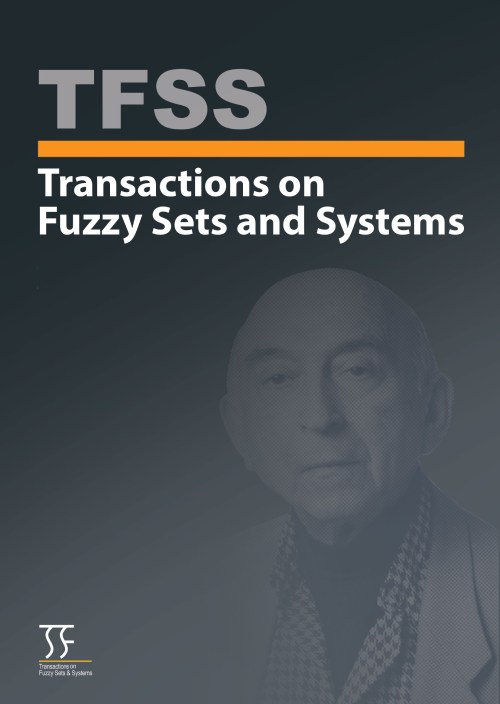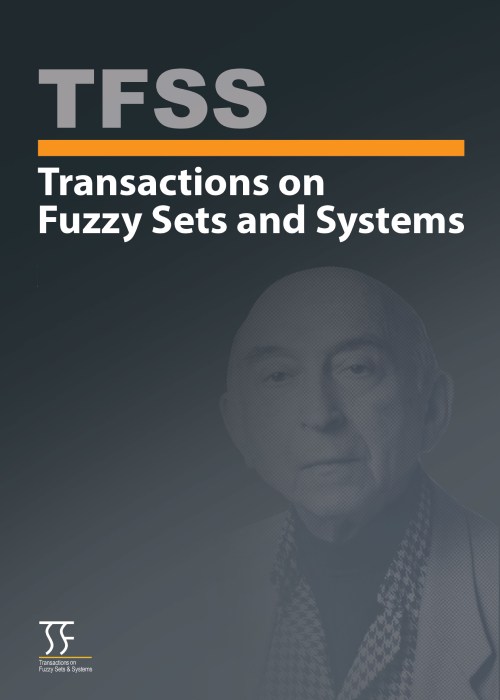فهرست مطالب

Transactions on Fuzzy Sets and Systems
Volume:1 Issue: 2, Fall - Winter 2022
- بهای روی جلد: 2ريال
- تاریخ انتشار: 1401/10/20
- تعداد عناوین: 12
-
Pages 1-5In this note we correct an error on the possible maximum difference between the (measure of dependence) Schweizer and Wolff's sigma and the absolute value of the (measure of concordance) Spearman's rho given in [B. Schweizer and E. F. Wolff, On nonparametric measures of dependence for random variables, Ann. Statist., 9 (1981), 879-885]. Moreover, we provide a possible value for that possible, leaving its proof as an open problem.Keywords: Copula, Schweizer, Wolff's $sigma$, Spearman's $rho$
-
Pages 6-20In this paper, we present some characterizations of the $LM$-fuzzy interior operator, the $LM$-fuzzy closure operator, $LM$-fuzzy semiopen operator and $LM$-fuzzy preopen operator in an $LM$-fuzzy topological space. Based on them, we introcuced the notions of $LM$-fuzzy regularly open operators and $LM$-fuzzy regularly closed operators and show that these kinds of openness degrees are di erent from those de ned by level $L$-topology.Keywords: $LM$-fuzzy topology, $LM$-fuzzy closure operator, $LM$-fuzzy semiopen operator, $LM$-fuzzy preopen operator, $LM$-fuzzy regular open operator
-
Pages 21-31People often change their minds at different times and at different places. It is important and valuable to indicate concept-drift patterns in unexpected ways for shopping behaviours for commercial applications. Research about concept drift has been growing in recent years. Many algorithms dealt with concept-drift information and detected new market trends. This paper proposes an approach based on fuzzy c-means (FCM) to mine the concept drift of fuzzy membership functions. The proposed algorithm is subdivided into two stages. In the first stage, individual fuzzy membership functions are generated from different training databases by the proposed FCM-based approach. Then, the proposed algorithm will mine the concept-drift patterns from the sets of fuzzy membership functions in the second stage. Experiments on simulated datasets were also conducted to show the effectiveness of the approach.Keywords: concept drift, Data mining, fuzzy c-means, Membership function
-
Pages 32-36In this paper, we have characterized big data fuzzy sets and shown that topological data points form singleton fuzzy sets which are closed. Besides, fuzzy sets of topological data points are compact and have at least one closed point. We have also shown that the fuzzy set of all condensation points of a fuzzy Hausdor space is in nite and the cardinality of a topological data fuzzy set is also in nite and arbitrarily distributed in fuzzy Hausdor spaces.Keywords: fuzzy set, Fuzzy topological space, Fuzzy Hausdorff space, Topological Data point
-
Pages 37-45The idea of Lukasiewicz $t$-conorm is used to construct the concept of Lukasiewicz anti fuzzy sets based on a given anti fuzzy set, and it is applied to BE-algebras. The notion of Lukasiewicz anti fuzzy BE-ideal is introduced, and its properties are investigated. The conditions under which Lukasiewicz anti fuzzy set will be Lukasiewicz anti fuzzy BE-ideal are explored, and the relationship between anti fuzzy BE-ideal and Lukasiewicz anti fuzzy BE-ideal are discussed. Three types of subsets so called $\lessdot$-subset, $\Upsilon$-subset, and anti subset are constructed, and the conditions under which they can be BE-ideals are explored.Keywords: Anti fuzzy BE-ideal, Lukasiewicz anti fuzzy set, Lukasiewicz anti fuzzy BE-ideal, $lessdot$-subset, $Upsilon$-subset, anti subset
-
Pages 46-58The present paper reviews and compares the main theories reported in the literature for managing the existing real life uncertainty by listing their advantages and disadvantages. Starting with a comparison of the bivalent logic (including probability) and fuzzy logic, proceeds to a brief description of the primary generalizations of fuzzy sets (FSs) including interval valued FSs, type-2 FSs, intuitionistic FSs, neutrosophic sets, etc. Alternative theories related to fuzziness are also examined including grey system theory, rough sets and soft sets. The conclusion obtained at the end of this discussion is that there is no ideal model for managing the uncertainty; it all depends upon the form, the available data and the existing knowledge about the problem under solution. The combination of all the existing models, however, provides a sufficient framework for efficiently tackling several types of uncertainty appearing in real life.Keywords: Uncertainty, Fuzzy set (FS), Interval valued FS (IVFS), Type-2 FS, Intuitionistic FS (IFS), Neutrosophic set (NS), Rough set, Soft set, Grey system (GS)
-
Pages 59-71A forensic dynamic $n$-valued Lukasiewicz logic $FDL_n$ is introduced on the base of $n$-valued Lukasiewicz logic $L_n$ and corresponding to it forensic dynamic $MV_n$-algebra ($FDL_n$-algebra), $1 < n < \omega$, which are algebraic counterparts of the logic, that in turn represent two-sorted algebras $(\mathcal{M}, \mathcal{R}, \Diamond)$ that combine the varieties of $MV_n$-algebras $\mathcal{M} = (M, \oplus, \odot, \sim, 0,1)$ and regular algebras $\mathcal{R} = (R,\cup, ;, ^\ast)$ into a single finitely axiomatized variety resemblig $R$-module with "scalar" multiplication $\Diamond$. Kripke semantics is developed for forensic dynamic Lukasiewicz logic $FDL_n$ with application to Digital Forensics.Keywords: Lukasiewiz Logic, Dynamic Logic, Epistemic Logic, MV-algebra
-
Pages 72-89As the research object of modern nonlinear science, a fractal theory has been an important research content for scholars since it comes into the world. Moreover, iterated function system (IFS) is a significant research object of fractal theory. On the other hand, the Markov process plays an important role in the stochastic process. In this paper, the iterated function system with probability(IFSP) and the infinite function system with probability(IIFSP) are investigated by using interlink, period, recurrence and some related concepts. Then, some important properties are obtained, such as: 1. The sequence of stochastic variable $\{\zeta_{n},(n\geq 0)\}$ is a homogenous Markov chain. 2. The sequence of stochastic variable $\{\zeta_{n},(n\geq 0)\}$ is an irreducible ergodic chain. 3. The distribution of transition probability $ p_{ij}^{(n)}$ based on $n\rightarrow\infty $ is a stationary probability distribution. 4. The state space can be decomposed of the union of the finite(or countable) mutually disjoint subsets, which are composed of non-recurrence states and recurrence states respectively.Keywords: Fractal, Markov process, Iterated function system, Probability
-
Pages 90-98The failure mode and effects analysis (FMEA) is a qualitative, Inductive and effective method for detecting errors, faults, and failures in a system and fuzzy logic can improve that technique with more logical outputs. Moreover, the fault tree analysis (FTA) as a probabilistic risk assessment method is among the effective technique for calculating the probability of errors, faults, failures, reliability and safety integrity level (SIL) verification resulting in certain events at higher levels. The FTA also detects the main causes of events in complicated systems. Although this technique appears to be time-consuming in systems with many diverse components, it is considered a powerful tool. In this paper, the fuzzy FMEA analyzes the failure modes in a hypothetical system. After that, the process with the highest risk is selected as the input of an FTA. According to the qualitative and quantitative analysis of FTAs, a series of corrective actions will be proposed to reduce the failure probability.Keywords: Fault Tree Analysis (FTA), Failure Mode, Effect Analysis (FMEA), Qualitative Risk Assessment. Probabilistic Risk Assessment (PRA), fuzzy number
-
Pages 99-128In the literature it is very common to see problems in which it is necessary to aggregate a set of data into a single one. An important tool able to deal with these issues is the aggregation functions, which we can highlight as the OWA functions. However, there are other functions that are also capable of performing these tasks, such as the preaggregation function and mixture functions. In this paper we investigate two special types of functions, the Generalized Mixture functions and Bounded Generalized Mixture functions, which generalize both OWA and Mixture functions. We also prove some properties, constructions and examples of these functions. Both the Generalized and Bounded Generalized Mixture functions are developed in such a way that the weight vectors are variables that depend on the input vector, which generalizes the aggregation functions: Minimum, Maximum, Arithmetic Mean and Median, and are extensively used in image processing. Finally, we propose a Generalized Mixture function, denoted by $\mathbf{H}$, and we show that $\mathbf{H}$ satisfies a series of properties in order to apply this function in an illustrative example of application: The image reduction process.Keywords: Aggregation functions, Preaggregation functions, OWA functions, Generalized Mixture functions, Image reduction
-
Pages 129-141In this paper, as a further generalization of fuzzy ideals, we introduce the notion of a fuzzy (soft) quasi-interior ideals of semirings and characterize regular semiring in terms of fuzzy (soft) quasi-interior ideals of semirings. We prove that $(\mu, A)$ is a fuzzy soft left quasi-interior ideal over a regular semiring $M,$ if and only if $(\mu, A)$ is a fuzzy soft quasi-ideal over a semiring $M,$ and study some of the properties.Keywords: Semiring, Regular semiring, Quasi-interior ideal, Fuzzy quasi-interior ideal, Fuzzy soft quasi-interior ideal
-
Pages 142-159In this paper, we define and study the category of L-algebras, proving that this category has equalizers, coequalizers, kernel pairs and products. We investigate the existence of injective objects in this category and show that an object in the subcategory of cyclic L-algebras is injective if and only if it is a complete and divisible cyclic L-algebra.Keywords: L-algebra, Cyclic L-algebra, MV-algebra, Equalizer, Product, Co-product


